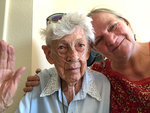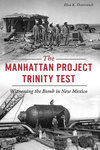Wind: 12.7 mph, S
Welcome to our new web site!
To give our readers a chance to experience all that our new website has to offer, we have made all content freely avaiable, through October 1, 2018.
During this time, print and digital subscribers will not need to log in to view our stories or e-editions.



The atomic age was officially brought to being in the desert of southern New Mexico where scientists with The Manhattan Project detonated the first atomic bomb on July 16, 1945, at what is known as the Trinity Site.
Much has been written about that capstone event, and The Bulletin’s own Elva Österreich is the latest to offer up an angle that teems with personal stories of people who lived and died on ranches and in communities nearby.
“The Manhattan Project Trinity Test: Witnessing the bomb in New Mexico,” was officially released by Arcadia Publishing Monday, Nov. 2.
Growing up in New Mexico, Österreich said she first heard about the bomb during her teens, but it wasn’t until she moved to Alamogordo years later that she began talking to people who remembered the day the sun rose twice bright above the desert floor.
She also visited the site in 2001 with her then-10-year-old son.
“I found it somewhat interesting, but not mind blowing or powerful in any way,” she said. “A black obelisk, a few big metal things and a little bit of trinitite left around for folks to see. They do have a table set up with docents sharing information and answering questions. The most exciting part of the trip for my son was being able to try a Geiger counter on several objects, including trinitite.”
Trinitite is the name given to glass-like chunks of molten sand that resulted from the intense heat of the bomb blast.
Österreich said The Alamogordo Daily News set out to do a commemorative edition of the 60th anniversary of the blast in 2005.
“The stories about that day and the possible repercussions for those in southern New Mexico made for some fascinating reading and some wonderful interviews completed by the staff at the paper at the time,” Österreich said.
The seed of the book began with that series of interviews. Österreich said most of the material she’d read about the Trinity Site, the bomb and its history and aftermath relied heavily on interviews with scientists and support personnel who either watched the blast from a safe distance or were involved in the project at some level. Österreich said she realized there were other, more personal stories waiting to be told.
There were sad stories of families ravaged by cancers through generations after the blast. There were funny stories about children told to hide under their beds while the armed adults went outside to see what the hell had just happened, and while hiding under the bed concocting ways they could, if necessary, defend themselves by throwing fruits and nuts at any invaders.
And there were bizarre stories about inner-earth aliens disturbed by the blast. One of those was attributed to a man named Mark Harp.
“Mr. Harp believed there was a humanoid civilization living inside the earth. He believed the Trinity Site explosion shook the whole earth, and the humanoids were disturbed and concerned by the event,” Österreich said. “They thought there might be some kind of danger approaching, so they sent a team out of a hole at the North Pole in a flying ship to New Mexico to see what was going on. Unfortunately, their vehicle malfunctioned, and in July 1947, they crashed into the New Mexico desert northeast of Trinity Site, creating the alien confusion known as the Roswell incident.”
Österreich said that while the book recreates the chain of events that led up to the blast and the historic repercussions of the dawn of the nuclear age, her goal was to focus on what it all meant to the people who saw the light or heard the boom that changed the world.
“I feel like this book makes an important piece of history accessible and relatable to people today at home and living in communities which could at any time be affected by the unknown and touched by something they never imagined,” she said. “I would hope it serves to create a kind of bridge of understanding between generations as well as individuals.”
“The Manhattan Project Trinity Test: Witnessing the bomb in New Mexico,” is available at COAS My Bookstore in Las Cruces and on Amazon, as well as from the publisher. Österreich said the book is going to be the subject of the Sage Book Club discussion on Dec. 10, and she will be doing local radio interviews that have yet to be scheduled.
Other items that may interest you
